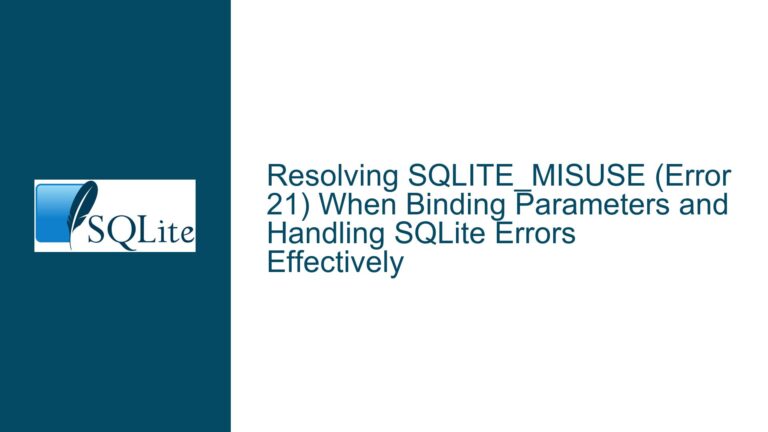SQLite WASM OPFS VFS: Single Worker Thread Challenges and Solutions
Understanding the WASM OPFS VFS Architecture and Worker Thread Constraints
The core issue revolves around the integration of SQLite with WebAssembly (WASM) and the Origin Private File System (OPFS) via a Virtual File System (VFS) layer. The primary challenge is the architectural design of the OPFS VFS, which necessitates the use of multiple worker threads due to the inherent mismatch between the asynchronous nature of OPFS and the synchronous requirements of the SQLite VFS API. This mismatch creates a scenario where the initialization of the VFS is forced into a worker thread, which then spawns another worker thread for the OPFS async proxy. This design is primarily driven by the need for a synchronization mechanism using SharedArrayBuffer (SAB) and Atomics.wait, which requires two threads to communicate effectively.
The OPFS VFS is designed to handle file operations in a web environment where direct synchronous file access is not possible. Instead, OPFS provides a partially asynchronous API, which complicates the integration with SQLite’s VFS, which expects fully synchronous operations. The use of multiple worker threads is a workaround to bridge this gap, allowing the asynchronous OPFS operations to be managed in a way that appears synchronous to SQLite.
However, this design raises questions about the feasibility of consolidating these operations into a single worker thread. The primary concern is whether the synchronization mechanisms can be maintained without the need for multiple threads. The discussion highlights that the current implementation of the OPFS VFS cannot operate within a single worker thread due to the fundamental differences in how OPFS and SQLite handle file operations.
Exploring the Feasibility of Single Worker Thread Operation
The possibility of operating the OPFS VFS within a single worker thread is explored, with a focus on the limitations imposed by the asynchronous nature of OPFS. The key limitation is the requirement for synchronous file access, which is not natively supported by OPFS. The current implementation uses a second worker thread to handle the asynchronous operations, ensuring that the main worker thread can continue to operate synchronously as required by SQLite.
The discussion introduces an alternative VFS implementation, referred to as "sahpool," which attempts to address this limitation by sidestepping the asynchronous createSyncAccessHandle method. This alternative approach allows for single-threaded operation but comes with its own set of trade-offs, particularly the limitation of no simultaneous connections. This means that while the sahpool VFS can operate within a single worker thread, it may not be suitable for all use cases, especially those requiring multiple concurrent connections to the database.
The sahpool VFS represents a significant shift in how the OPFS integration is handled, focusing on reducing the complexity of the worker thread architecture. By eliminating the need for a second worker thread, the sahpool VFS simplifies the overall design but at the cost of reduced functionality. This trade-off is acceptable in scenarios where simultaneous connections are not required, making it a viable option for certain applications.
Implementing a Simplified Interface and Achieving Feature Parity
The final part of the discussion focuses on the practical implementation of a simplified interface for the OPFS VFS, with the goal of achieving feature parity with the current demo while reducing reliance on external dependencies. The primary objective is to create a single worker thread implementation that can handle all necessary operations without the need for additional worker threads.
The simplified interface aims to provide a more streamlined experience for developers, reducing the complexity of integrating SQLite with OPFS in a web environment. This involves removing unnecessary dependencies, such as the emscripten fs utility, and focusing on core functionality. The goal is to make the code tree-shakable, allowing developers to include only the necessary components in their projects, thereby reducing the overall size and complexity of the final application.
Achieving feature parity with the current demo is a critical aspect of this effort. The demo serves as a benchmark for the functionality and performance of the OPFS VFS, and any simplified implementation must meet or exceed these standards. This involves ensuring that all core features, such as file access, synchronization, and error handling, are fully supported in the single worker thread implementation.
The discussion also touches on the importance of reducing reliance on attaching objects to global namespaces, which can lead to code bloat and potential conflicts. By focusing on modular design and tree-shaking, the simplified interface can provide a more efficient and maintainable solution for developers.
Conclusion
The integration of SQLite with OPFS via a VFS layer in a web environment presents unique challenges, particularly around the handling of asynchronous file operations in a synchronous context. The current implementation of the OPFS VFS requires multiple worker threads to manage these operations effectively, but alternative approaches, such as the sahpool VFS, offer the possibility of single-threaded operation with certain trade-offs.
The development of a simplified interface for the OPFS VFS aims to reduce complexity and improve maintainability, while still achieving feature parity with existing implementations. By focusing on core functionality and reducing reliance on external dependencies, this approach provides a more streamlined experience for developers, making it easier to integrate SQLite with OPFS in web applications.
In summary, the key to resolving the challenges of the OPFS VFS lies in understanding the architectural constraints and exploring alternative implementations that can operate within a single worker thread. By doing so, developers can create more efficient and maintainable solutions for integrating SQLite with OPFS in a web environment.






